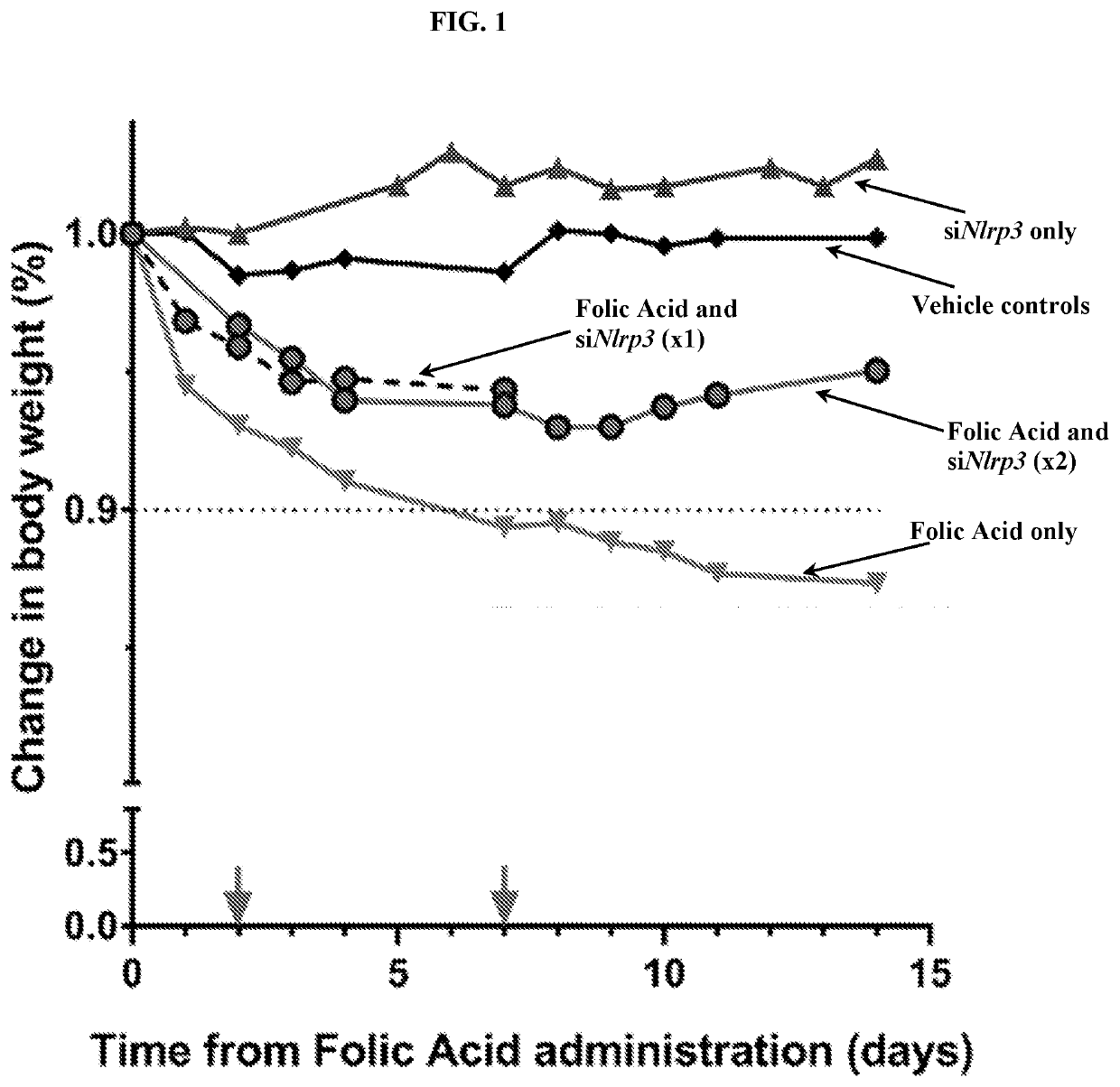Inflammasome-targeted RNA interference approach to treating kidney injury and disease
- Summary
- Abstract
- Description
- Claims
- Application Information
AI Technical Summary
Benefits of technology
Problems solved by technology
Method used
Image
Examples
example 1
tal Materials and Methods
[0119]Synthesis and Characterization of the Soluble, Functionalized Single Walled Carbon Nanotube Construct: The fCNTs were prepared and characterized via covalent cycloaddition of azomethine ylides with SWCNT, see McDevitt et al., PloS One, 2007, 2:e907; McDevitt et al., Society of Nuclear Medicine, 2007, 48:1180-1189; Ruggiero et al., Proc. Nat. Acad. Sci., 2010, 107:12369-12374; Alidori, et al., J. Phys. Chem. C., 2013, 117:5982-5992; Villa, et al., Nano Letters, 2008, 8:4221-4228. Characterization using different analytical techniques (Transmission Electron Microscopy (TEM), Dynamic-Light-Scattering (DLS), Kaiser assay, RP-HPLC and spectrofluorometric titration with siRNA sequences) revealed an amine content of 0.3 mmol / g of fCNT and chemical purity >99%. Dicer validated RNA sequences (Hefner, et al., J. Biomol. Tech., 2008, 19:231-237) were designed to silence NLR pyrin domain-containing protein 3 (NLRP3). The non-covalent binding of fCNT and siRNA was ...
example 2
ibility and Non-Toxicity of siNlrp3 / fCNT in a Mouse Model of Chronic Kidney Disease
[0133]To determine if targeted therapy with siNlrp3 / fCNT was non-toxic in a mouse model of chronic kidney disease, the change in body weight (%) of treated mice was monitored over time following folic acid administration (FIG. 1). Mice received intraperitoneal (IP) injections of 225 to 250 mg / kg Folic acid (FA) to induce a chronic disease state. siNlrp3 / fCNT was delivered to the renal proximal tubule cells 2 days and 7 days after FA injury using sidewall ammonium-functionalized carbon nanotubes (fCNT) as the delivery platform. Control groups included siNlrp3 only to determine the biocompatibility of the treatment in the absence of the FA, naïve animals receiving only vehicle (i.e. no siNlrp3 / fCNT or FA), and treatment with FA only.
[0134]FIG. 1 shows that the FA only-treated group of animals displayed severe weight loss (>10% decrease from baseline) within 1 week of FA administration. siNlrp3 / fCNT-trea...
example 3
CNT Improves the Overall Health of Chronic Kidney Disease Animals
[0137]siNlrp3 / fCNT treatment successfully minimized symptoms in a chronic kidney disease mouse model. Vehicle treated mice were administered a single dose of PBS and sacrificed on day 14. Folic acid only treated mice were administered a single dose of FA and sacrificed on day 14. FA+siNlrp3 / fCNT treated mice were administered FA and one or two doses of siNlrp3 / fCNT 48 hours later (mice treated with a single dose of siNlrp3 / fCNT were sacrificed on day 7 and mice treated with two doses were sacrificed on day 14). siNlrp3 only treated mice were administered a single dose of siNlrp3 and sacrificed on day 14. All H&E sections were blindly scored using a semi-quantitative scale from 0 to 4 (0=no lesions; 1=minimal lesions; 2=mild lesions; 3=moderate lesions; and 4=marked lesions; FIG. 3(F)).
[0138]Histological analysis by hematoxylin and eosin (H&E) staining of kidney samples from mice treated with siNlrp3 / fCNT (single dose, ...
PUM
| Property | Measurement | Unit |
|---|---|---|
| Time | aaaaa | aaaaa |
| Composition | aaaaa | aaaaa |
| Molar ratio | aaaaa | aaaaa |
Abstract
Description
Claims
Application Information
 Login to View More
Login to View More - R&D
- Intellectual Property
- Life Sciences
- Materials
- Tech Scout
- Unparalleled Data Quality
- Higher Quality Content
- 60% Fewer Hallucinations
Browse by: Latest US Patents, China's latest patents, Technical Efficacy Thesaurus, Application Domain, Technology Topic, Popular Technical Reports.
© 2025 PatSnap. All rights reserved.Legal|Privacy policy|Modern Slavery Act Transparency Statement|Sitemap|About US| Contact US: help@patsnap.com



